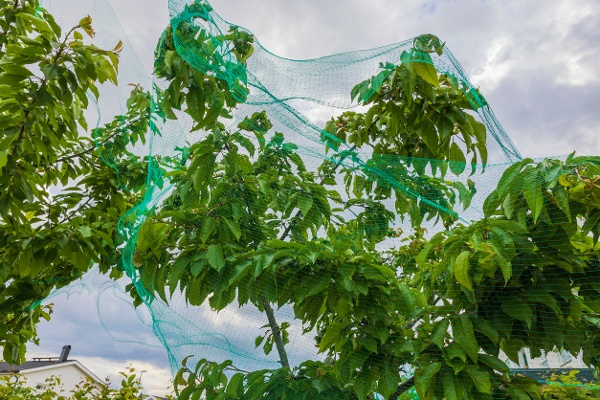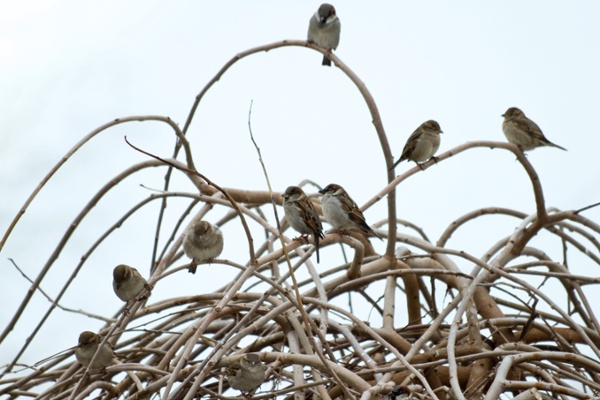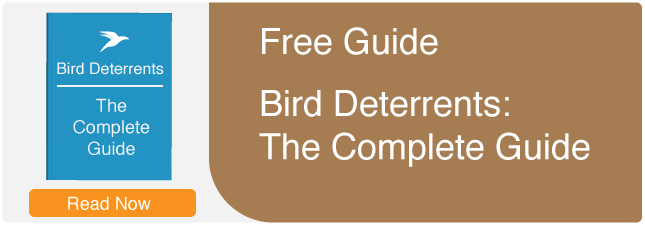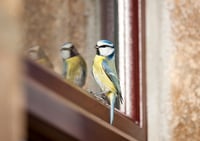 Birds living, roosting, and nesting in trees are a common sight that is welcome in wooded areas and parks. However, when birds make their homes in trees that line streets or beautify public spaces like retail or medical center outdoor areas, it can present a distressing problem. Finding a bird control solution that works to keep birds out of specific trees can be a challenge. In the past, bird netting has been the most common option. However, the hazards of bird netting on trees include damage to trees and other issues.
Birds living, roosting, and nesting in trees are a common sight that is welcome in wooded areas and parks. However, when birds make their homes in trees that line streets or beautify public spaces like retail or medical center outdoor areas, it can present a distressing problem. Finding a bird control solution that works to keep birds out of specific trees can be a challenge. In the past, bird netting has been the most common option. However, the hazards of bird netting on trees include damage to trees and other issues.
Why Protect Trees From Birds?
In many areas, birds in trees aren't an issue for anyone. Trees offer a safe home for birds and pose little harm to nearby houses and public spaces. However, pest birds in trees in some areas can be a big problem. Bird waste is messy and smelly. It can even present serious health problems, especially for individuals with underlying health issues.
Nesting birds can also be territorial. When they create nests in trees near the entrance of a commercial building, every visitor could be risking an attack from a mother bird attempting to protect her young.
The benefits of growing trees in cities and towns are undeniable. Trees filter the air. When planted strategically, trees can cool the air by between 2 and 8 degrees Celsius. That means trees can make cities 14 degrees Fahrenheit cooler. Unfortunately, birds don't distinguish between trees in rural or wooded areas and those in urban areas. Trees in urban areas can even be more attractive if they offer additional food sources and fewer threats to birds.
In agricultural areas, farmers and orchard owners need to protect fruit trees from being destroyed by hungry birds. In urban areas, property owners need to protect the property where trees grow and the individuals who use the property.
The Hazards of Bird Netting on Trees
Traditionally, bird netting is considered one of the most common methods for protecting trees from birds. The tree limbs are fully draped with netting that keeps pest birds from reaching branches and twigs to roost on. In theory, bird netting is an effective exclusion product that mostly prevents birds from using the trees. However, it can create issues that harm the trees, some birds, and the people around netted trees.
These are the most common hazards of bird netting on trees:
1. Stunted Tree Growth
For bird netting application, the tree is trimmed into a round shape, and netting is applied from the bottom of the limbs and gathered at the top. Trimming trees in this unnatural lollipop shape can stunt tree growth. The application of the netting can also affect limb growth.
2. Trapped Birds
While bird netting is largely effective at keeping birds out, damaged netting or small birds can create exceptions. Birds that manage to get past bird netting on trees could get injured or become trapped behind the netting.
3. Added Landscaping Requirements
To access trees for trimming or other maintenance, netting must be opened up frequently. This creates an extra step in any landscaping job.
4. Unattractive Environment
Trees are naturally beautiful. But those that are trimmed unnaturally and covered with restrictive nets are unattractive and provide limited shade.
5. Sagging Nets Can Be Dangerous
Trees naturally shed leaves and branches. The debris that can't fall to the ground causes nets to sag. Netted trees lining streets can also become a major hazard when sagging nets affect tall vehicles. Buses and other vehicles can hit and drag nets, damaging trees or even pulling them up by the roots.
Modern Bird Control Solutions That Help You Avoid the Hazards of Bird Netting on Trees
The hazards of bird netting on trees can cause a perplexing problem. We know that trees provide benefits and that birds can cause damage to the surroundings and put human health at risk. But bird netting can also cause a variety of issues.
Luckily, when it comes to modern pest bird control, there are other solutions. Although many properties still use bird netting on trees, there are a few major solutions that can provide more effective bird control without the same hazards of bird netting. Consider how these solutions protect trees from pest birds.
Tree Shock
Designed to protect trees while maintaining an aesthetically pleasing appearance, Tree Shock is applied directly to tree branches. When a bird or other animal's foot touches the positive and negatively charged wires, the creature gets a slight shock that trains it to stay away. This shock is minimal and causes no harm to even the smallest birds.
While Tree Shock is completely harmless and cannot affect humans, some property owners in public places and commercial properties fear liability issues with the use of Tree Shock. Since children sometimes climb or touch trees, there is the potential that they could touch the product and feel a small shock. Even though there is no potential for harm with such an encounter, some property owners prefer to stay away from Tree Shock as a potential solution.
Optical Gel
Optical Gel is a multi-sensory bird repellent that deters birds through sight, smell, and touch. Contained in dishes, Optical Gel is a harmless repellent that looks like fire or smoke to birds. It also has a strong odor of citronella and peppermint that is offensive to birds and is sticky to the touch. Optical Gel is typically applied to tree branches with zip ties.
Optical Gel is completely harmless, very effective, and eliminates the liability concerns some property owners have about Tree Shock. The product is easy to install but might require some trimming and thinning of tree branches before application.
Finding New Bird Control Solutions for Ongoing Pest Bird Issues
 Years ago, netting was the most effective option for protecting trees from pest birds. But bird control specialists are constantly creating new solutions that effectively repel pest birds without harming birds or the surrounding environment. Both solutions outlined above offer an aesthetically pleasing, environmentally sustainable, and safe solution for keeping pest birds out of trees. However, many property owners, company boards, and even government-run areas (like towns and cities) automatically turn to netting to protect trees.
Years ago, netting was the most effective option for protecting trees from pest birds. But bird control specialists are constantly creating new solutions that effectively repel pest birds without harming birds or the surrounding environment. Both solutions outlined above offer an aesthetically pleasing, environmentally sustainable, and safe solution for keeping pest birds out of trees. However, many property owners, company boards, and even government-run areas (like towns and cities) automatically turn to netting to protect trees.
When it comes to solving any pest bird problem, information and knowledge are your most powerful tools. No matter where you choose to purchase your bird control products and tools, talking to an expert can help you find a product for a customized solution.
When you contact a bird control professional, you can provide information and even photos that better define your situation. The expert can then describe a variety of solutions and the challenges you might encounter when using these tools in your unique situation. Many people use netting on trees because they're unaware that other more effective, less damaging solutions exist. If you're facing a pest bird issue on your property, arm yourself with information to make the most informed decision about the right solution.
About Bird Barrier
Bird Barrier is a leader in innovative technology designed to prevent birds from landing, roosting or nesting. We specialize in urban bird control to remove birds humanely and effectively. Our website, birdbarrier.com, hosts a wealth of content to help people understand and identify bird control solutions for various problems with pest birds. Please contact us if you need help with a bird related problem. You may also benefit from our free guide, Bird Deterrents: The Complete Guide.






